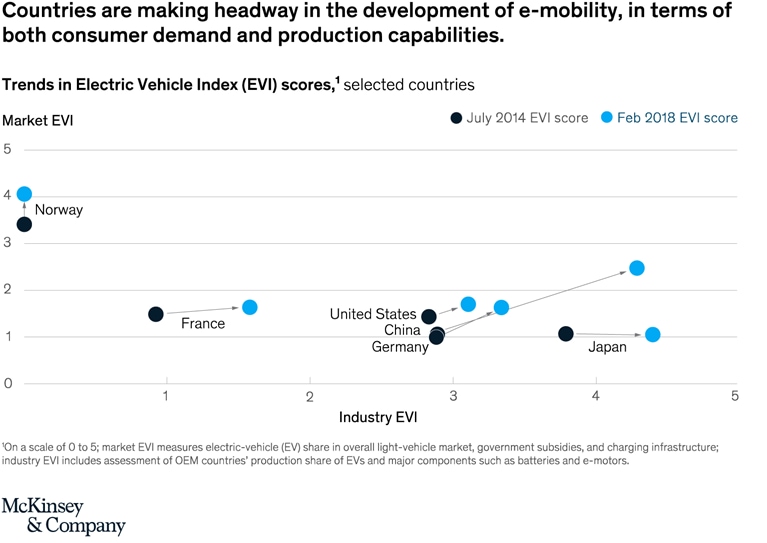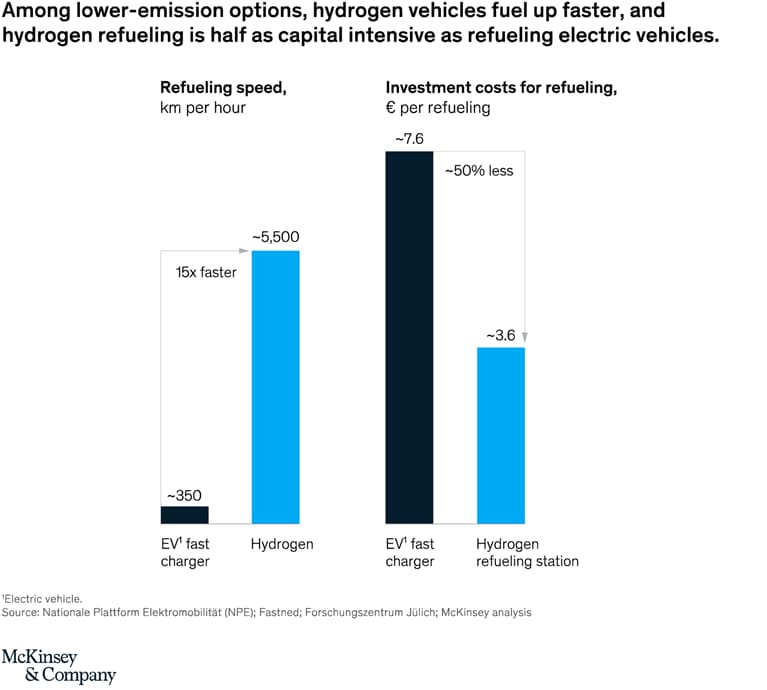During London’s 1894 ‘Great Horse Manure Crisis’, it was believed that the city and its then 50,000 horses would one day be buried under manure. But within 25 years, following the introduction of Ford’s motor car, the manure problem had ceased to exist.
We are on the verge of another great disruption. By 2030, we’ll see developments that may be as profound as those a hundred years before. Fixtures of today’s world—gas stations, parking lots, traffic jams—will become relics. Likewise, the environmental scourges they produce—congestion and pollution—will diminish substantially. Mobility is on the verge of becoming more sustainable, cheap, convenient, and connected.
Electrification and vehicle autonomy will usher in a broader, more integrated mobility network
Electric vehicles (EVs) are quickly becoming mainstream, and manufacturers are feeling bullish: Fewer than 5 percent of vehicles sold in 2016 had EV power trains, but manufacturers expect to raise that to 50 percent by 2021. EVs are not confined to passenger automobiles—electric buses, trucks, and other delivery vehicles are heading toward commercialization. EVs are not only more sustainable, but they are cheaper to use, with the overall cost of ownership lower than gasoline-powered vehicles.

Then there are autonomous vehicles (AVs). Only about 1 percent of vehicles sold in 2016 had even partial AV technology. But today, eight of the 10 largest manufacturers plan to have autonomous road-ready technology by 2025. Some players are already getting a head start. Google’s Waymo launched a commercial taxi service made of AVs last year, Uber plans to do so this year, and Lyft will follow in 2021. By 2030, 80 percent of Chinese, European, and U.S. miles will be clocked using self-driving vehicles.
The automotive industry for more than a century has operated alongside but decidedly separate from the broader transportation sector. In fact, automotive makes up only a quarter of the $8 to $10 trillion spent each year on the transport of people and goods. The new mobility ecosystem will ensure that automotives are much better integrated into the broader transportation sector, so that fuel, sustainability, insurance, finance, and maintenance can all be considered together in cost-saving ways. Automobiles today are disconnected from one another: Because they can’t be tracked, they can’t be properly guided to prevent traffic jams and reduce carbon emissions from wasteful idling. A more integrated mobility ecosystem will also help mitigate the financial and human costs associated with heavy traffic and pollution.
Hydrogen fuel cell cars and EVs may complement each other in a decarbonized mobility future
Vehicles powered by hydrogen fuel cells have started to trickle into select markets across Asia, Europe, and North America. While technical and infrastructural challenges remain, hydrogen has several clear advantages over batteries. For one, refueling hydrogen vehicles is about 15 times faster than refueling battery-powered EVs—even those that use so-called fast-charging technology. Hydrogen fueling also requires about 10 times less space and is half as capital intensive as EV fast charging. And while hydrogen is the most common element in the universe, battery-powered vehicles are dependent on limited natural resources such as cobalt, nickel, and lithium, the growing demand for which leads to cost and ecological concerns.
At the moment, however, EVs still have a much greater market presence than fuel cell vehicles, and there are still high costs associated with producing hydrogen. At the same time, hydrogen vehicles come into their own in specific use cases. There is a greater opportunity for hydrogen power as vehicles get heavier and require longer ranges. A hydrogen-powered 40-ton semitruck, for example, when produced at scale, draws even with a battery-powered truck in costs at slightly more than 100 kilometers range while allowing for a three-ton greater payload. When it comes to hydrogen cars or battery electric vehicles, it is not and either or question—but rather, why not both?

Profiting for good
Just as a century ago, Henry Ford prioritized an affordable wage and created a base of loyal car-buying employees, thus multiplying sales. In the new mobility ecosystem, winning is also interconnected: CEOs should measure success against the benefits to society at large. Importantly, the changing dynamics mean that many businesses that do not consider cars to be close to their core industry will find themselves confronting an increasingly far-reaching mobility ecosystem.
How precisely cars, roads, and the customer experience will evolve is still unknown. But now is the time to take advantage by testing out pilots to gain knowledge in connected businesses, tracking progress with actionable timelines and incentives, and acquiring and developing talent prepared for the coming changes in mobility.
